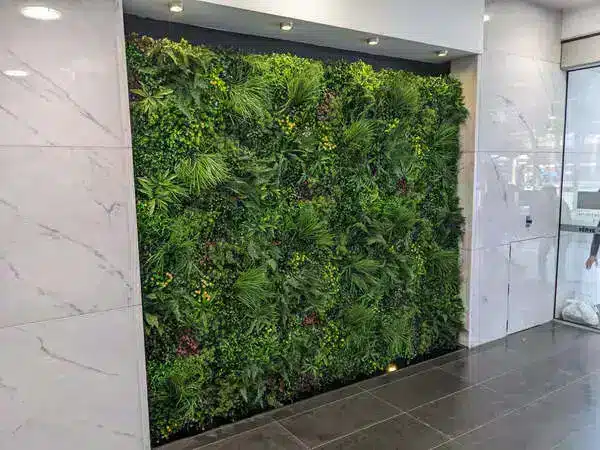Most of the time, when we consider planting a garden we think of the horizontal space available. If you want to increase your ability to grow and decorate with live plants, consider also growing vertically. This increases your ability to grow especially in limited spaces.
But vertical growing does come with several challenges, and we’re sure you’re here with multiple questions about how to maintain a vertical garden. Let’s explore the key pain points and how to address them effectively.
Understanding the Basics of Vertical Garden Maintenance
Before you learn how to maintain your vertical garden, it’s important to know the main components that make a good garden! There are 3 things that create the stunning vertical garden you’re looking to create:
Structure and Framework
This is the backbone of your natural vertical garden, supporting the plants, soil, and irrigation system.

Soil or Growth Medium
The growing medium is where your plants anchor their roots and draw essential nutrients. Common options include lightweight potting mixes, coco coir, or even hydroponic setups. Ensure the medium retains moisture effectively while allowing excess water to drain, preventing root rot. Periodically testing and refreshing the growing medium also helps sustain healthy plant growth.
Irrigation Systems
Watering a vertical garden can be tricky due to its structure. However, a well-designed irrigation system simplifies this task. Automated drip systems are ideal as they deliver water directly to the roots, conserving water and ensuring consistent hydration. Plus, you can monitor your irrigation setup regularly for blockages or leaks to maintain optimal performance.
Benefits of Proper Maintenance
Now if you’re wondering why so much goes into vertical garden care and maintenance, we’ve got you a few benefits too:
Helps your plants thrive
Proper care doesn’t just help your plants survive—it ensures they thrive. Regular watering, pruning, and feeding lead to robust growth, reducing the need to replace plants frequently. Over time, this consistency saves both time and money.
Enhances visual appeal
Imagine a vertical garden that’s always lush, vibrant, and teeming with life. That’s the reward of regular maintenance! Keeping your garden in top shape transforms it into a striking focal point that uplifts your mood and enhances your living space. Whether it’s a cascading wall of greenery or a vibrant mix of colourful flowers, a well-maintained garden is truly a feast for the eyes.
Improves air quality
Healthy plants do more than just look good—they actively filter the air around them. As they remove toxins and release oxygen, your vertical garden becomes a natural air purifier. This creates a fresher, more invigorating environment, whether your garden is indoors or out!
Daily and Weekly Maintenance Tasks
Watering Techniques
It might seem like a no-brainer when it comes to learning how to maintain vertical gardens. However, wrong water techniques are one of the top mistakes people make when focusing on vertical garden maintenance.

- The type of plant you have: Different vertical garden plants have different watering needs. Overwatering and underwatering both have their negative side effects. Tropical plants may need daily watering, while succulents require less frequent attention.
- The climate you live in: Climate plays an undeniable role in how quickly you’ll need to water your vertical garden. Hotter regions will require more water, whereas shaded or cooler areas may need less. Adjust schedules as the seasons change.
- The soil’s moisture level: A simple way to check soil moisture is by inserting your finger into the medium. If it feels dry beyond the top inch, it’s time to water. Alternatively, use a moisture meter for precise readings, especially for larger vertical gardens.
Pruning and Trimming
Pruning and trimming are essential for keeping your vertical garden looking its best and growing healthily. It doesn’t matter whether your vertical garden is in schools or homes. They ensure that your plants don’t just survive but thrive in their vertical home.
The first step to pruning and trimming is to cut out dead leaves and overgrowth. Dead leaves not only detract from the garden’s appearance but can also become a haven for pests and diseases. Regularly removing them keeps your garden healthier overall.

Vines are a popular choice in vertical gardens, but they can be unruly. Looking for some best tips to deal with unruly vines? Use clean, sharp pruning shears to cut back excessive growth. This encourages the plant to produce new, healthy shoots and prevents tangling.
Training vines to follow the garden’s structure can also create a more cohesive and visually appealing design. Redirecting their growth along trellises or supports helps maintain an orderly and artistic layout while keeping the overall garden tidy.
Fertilizing and Soil Care
Now let’s talk fertilizers and soil care. These two are some of the most critical factors that determine how well your vertical garden thrives. For this, we have a few tips.
First and foremost, pick the right fertilizer for your vertical garden. This is because vertical gardens thrive on the right nutrients. Use slow-release fertilizers or liquid feeds tailored to your plant’s specific needs. Organic fertilizers, like compost teas, are excellent for promoting long-term soil health while being eco-friendly.
But remember, you can’t overfertilize them! Over-fertilizing can lead to salt buildup in the soil, which harms plants. Look for signs such as yellowing leaves or stunted growth to identify imbalances. Stick to recommended doses and dilute liquid fertilizers to avoid overwhelming your plants.
Over time, the growing medium may compact or lose nutrients. Refresh it by gently removing the top layer and adding new, nutrient-rich soil. But if you’ve got a hydroponic system in place, replace the nutrient solution periodically to keep it balanced and effective.
Dealing with Pests and Diseases
Vertical gardens are no strangers to common pests! They can weaken plants by sucking sap, causing leaf damage, or spreading diseases. Some of the most common pests found in vertical gardens are:
- Aphids
- Leaf miners
- Gastropods
- Caterpillars
- Spider mites
- Mealybugs
- Thrips
- Cutworms
So how do you battle them? You can easily pick between a natural pest control method or go for a chemical solution. Here is the main difference between them:
- Natural Solutions: Introduce beneficial insects like ladybugs, which prey on harmful pests. Neem oil sprays are a safe, organic option that disrupts pest life cycles without harming your plants.
- Chemical Solutions: For severe infestations, consider targeted pesticides labelled safe for edible plants if applicable. Always follow instructions carefully to avoid harming the environment or beneficial insects.
But what if your vertical garden hasn’t got any creepy crawlies? What if you’re dealing with a plant disease? Well, this is where we tell you what to look out for. Diseases often manifest as spots, discolouration, or wilting.
For fungal infections specifically, you should reduce moisture levels and apply fungicides as directed on the containers. If needed, remove the infected plant before the disease spreads to the rest of the garden.
Seasonal Maintenance for Vertical Gardens
Caring for a vertical garden requires attention to the changing seasons, as different plants have varying needs throughout the year. Tailoring your maintenance routine to the seasons helps ensure your vertical garden thrives year-round.
Adapting Care Routines for Different Seasons
Each season presents unique challenges for vertical garden care. During the summer months, focus on increasing watering frequency and keeping an eye out for signs of heat stress, such as wilting or scorched leaves.
In spring, it’s all about planting, fertilizing, and setting the stage for new growth. Fall is the time to prepare for cooler weather so you’ll want to prune back plants and add a layer of mulch to insulate roots and retain soil warmth.
So what about the winters? Well, winters are a tad bit more complicated than the other seasons. Frost can be a silent killer for many plants. If you have frost-sensitive greenery, consider moving these plants indoors during the colder months. For outdoor plants, frost cloths work wonders to provide a protective shield.
As the chill of winter fades, spring becomes the perfect opportunity for revitalization. Take the time to clean your garden’s framework, replacing any worn or damaged components. Refresh the growing medium with nutrient-rich soil to give your plants a fresh start.
Troubleshooting Common Issues
Uneven growth or wilting plants
Uneven growth often indicates inconsistent light or water distribution. Reassess the placement of plants—those requiring more light should be positioned higher, while shade-tolerant plants can thrive at the bottom. Adjust your irrigation system to address uneven watering.
Poor drainage
Poor drainage can lead to waterlogged soil and root rot. In other words, we mean the death of your vertical garden. But the solution to this is quite simple! Make sure your vertical garden has adequate drainage holes and that the irrigation system doesn’t overwhelm the structure. You can also incorporate gravel or sand into the soil mix to improve the drainage situation.
Structural damage
Vertical garden frameworks endure constant exposure to weather and weight. And that’s why you need to keep a close eye on signs of wear such as rust or cracks. Repair or replace damaged parts promptly. You can even consider reinforcing the structure if you’ve added new plants or heavier growing mediums!
Conclusion
Now that we’re at the end, we’re sure maintaining a vertical garden is looking quite daunting! They require a lot of care and attention, and things can still go wrong. That’s exactly why our artificial yet lifelike vertical garden is a popular hit amongst enthusiasts!
















